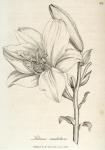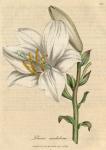101. Lilium candidum. Common white lily.

 Synonyma. Lilium album. Pharm. Edinb. Gerard Emac. p. 190. Raii Hist. p. 1109.
Synonyma. Lilium album. Pharm. Edinb. Gerard Emac. p. 190. Raii Hist. p. 1109.
Lilium album vulgare. Park. Parad. 39. J. Bauh. Hist. ii. p. 685.
α Lilium album flore erecto et vulgare. Bauh. Pin. p. 76.
β Lilium album floribus dependentibus sive peregrinum. Bauh. Pin. p. 76. Nodding-Flowered White Lily.
Class Hexandria. Ord. Monogynia. Lin. Gen. Plant. 410.
Ess. Gen. Ch. Cor. 6-petala, campanulata: linea longitudinali nectarifera. Caps. valvulis pilo cancellato connexis.
Spec. Char. L. foliis sparsis, corollis campanulatis: intus glabris.
The root is a large bulb, from which proceed several succulent fibres: the stem is firm, round, upright, simple, and usually rises about three feet in height: the leaves are numerous, long, narrow pointed, smooth, without footstalks, and irregularly scattered over the item: the flowers are large, white, and terminate the stem in clusters upon short peduncles: it has no calyx: the corolla is bell-shaped, consisting of six petals, which within are of a beautiful shining white, but without ridged, and of a less luminous whiteness: the filaments are six, tapering, much shorter than the corolla, upon which are placed transversely large orange-coloured antherae: the style is longer than the filaments, and furnished with a fleshy triangular stigma: the germen becomes an oblong capsule, marked with six furrows, and divided into three cells, which contain many flattish seeds of a semicircular form. It flowers in June and July.
This Lily, which now very commonly decorates the borders of our gardens with the beautiful whiteness [Alluding to this, Ovid, in the luxuriancy of his imagination, ascribes its origin to the milk of Juno. "Dum puer Alcides Divas vagus ubera suxit / Junonis, dulci pressa sapore suit; / Ambrosiumque alto lac distillavit Olympo / In terras fusum Lilia pulchra dedit." Pliny says, Lilium Rosae nobilitate proximum est; and both these flowers have furnished their share of metaphor to ancient and modern poets. Either singly, -- vel mixta rubent ubi lilia multâ / Alba rosâ: tales virgo dabat ore colores. Aen. lib. xii. 68.] of its flowers, is a native of the Levant, and has been cultivated here since the time of Gerard. The flowers of this plant have a pleasant sweet smell, and were formerly used for medicinal purposes; [Particularly as an antiepileptic and anodyne.] a watery distillation of them was employed as a cosmetic, and the oleum liliorum was supposed to possess anodyne and nervine powers; but the odorous matter of these flowers is of a very volatile kind, being totally dissipated in drying, and entirely carried off in evaporation by rectified spirit as well as water; and though both menstrua become impregnated with their agreeable odour by infusion or distillation, yet no essential oil could be obtained from several pounds of the flowers. It is therefore the roots only which are now directed by the Edinburgh College: they are extremely mucilaginous, and are chiefly used, boiled with milk or water, in emollient and suppurating cataplasms: it is probable however, that the poultices formed of bread or farina, possess every advantage of those prepared of Lily root.
Lilium (greek) vel (greek). By the Greeks it is called (greek).

